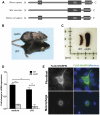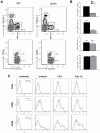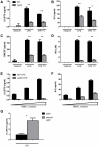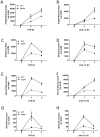SHARPIN is essential for cytokine production, NF-κB signaling, and induction of Th1 differentiation by dendritic cells
- PMID: 22348129
- PMCID: PMC3279418
- DOI: 10.1371/journal.pone.0031809
SHARPIN is essential for cytokine production, NF-κB signaling, and induction of Th1 differentiation by dendritic cells
Abstract
Spontaneous mutations of the Sharpin (SHANK-associated RH domain-interacting protein, other aliases: Rbckl1, Sipl1) gene in mice result in systemic inflammation that is characterized by chronic proliferative dermatitis and dysregulated secretion of T helper1 (Th1) and Th2 cytokines. The cellular and molecular mechanisms underlying this inflammatory phenotype remain elusive. Dendritic cells may contribute to the initiation and progression of the phenotype of SHARPIN-deficient mice because of their pivotal role in innate and adaptive immunity. Here we show by flow cytometry that SHARPIN- deficiency did not alter the distribution of different DC subtypes in the spleen. In response to TOLL-like receptor (TLR) agonists LPS and poly I:C, cultured bone marrow-derived dendritic cells (BMDC) from WT and mutant mice exhibited similar increases in expression of co-stimulatory molecules CD40, CD80, and CD86. However, stimulated SHARPIN-deficient BMDC had reduced transcription and secretion of pro-inflammatory mediators IL6, IL12P70, GMCSF, and nitric oxide. Mutant BMDC had defective activation of NF-κB signaling, whereas the MAPK1/3 (ERK1/2) and MAPK11/12/13/14 (p38 MAP kinase isoforms) and TBK1 signaling pathways were intact. A mixed lymphocyte reaction showed that mutant BMDC only induced a weak Th1 immune response but stimulated increased Th2 cytokine production from allogeneic naïve CD4(+) T cells. In conclusion, loss of Sharpin in mice significantly affects the immune function of DC and this may partially account for the systemic inflammation and Th2-biased immune response.
Conflict of interest statement
Figures







Similar articles
-
Systems analysis identifies an essential role for SHANK-associated RH domain-interacting protein (SHARPIN) in macrophage Toll-like receptor 2 (TLR2) responses.Proc Natl Acad Sci U S A. 2011 Jul 12;108(28):11536-41. doi: 10.1073/pnas.1107577108. Epub 2011 Jun 27. Proc Natl Acad Sci U S A. 2011. PMID: 21709223 Free PMC article.
-
Human heat shock protein 60 induces maturation of dendritic cells versus a Th1-promoting phenotype.J Immunol. 2003 Mar 1;170(5):2340-8. doi: 10.4049/jimmunol.170.5.2340. J Immunol. 2003. PMID: 12594256
-
IL-4 blocks TH1-polarizing/inflammatory cytokine gene expression during monocyte-derived dendritic cell differentiation through histone hypoacetylation.J Allergy Clin Immunol. 2013 Dec;132(6):1409-19. doi: 10.1016/j.jaci.2013.08.039. Epub 2013 Oct 17. J Allergy Clin Immunol. 2013. PMID: 24139608
-
Genetic and Epigenetic Regulation of the Innate Immune Response to Gout.Immunol Invest. 2023 Apr;52(3):364-397. doi: 10.1080/08820139.2023.2168554. Epub 2023 Feb 6. Immunol Invest. 2023. PMID: 36745138 Review.
-
SHARPIN is a key regulator of immune and inflammatory responses.J Cell Mol Med. 2012 Oct;16(10):2271-9. doi: 10.1111/j.1582-4934.2012.01574.x. J Cell Mol Med. 2012. PMID: 22452937 Free PMC article. Review.
Cited by
-
Comprehensive Pan-Cancer Genomic Analysis Reveals PHF19 as a Carcinogenic Indicator Related to Immune Infiltration and Prognosis of Hepatocellular Carcinoma.Front Immunol. 2022 Jan 5;12:781087. doi: 10.3389/fimmu.2021.781087. eCollection 2021. Front Immunol. 2022. PMID: 35069553 Free PMC article. Clinical Trial.
-
MODULATING CO-STIMULATION DURING ANTIGEN PRESENTATION TO ENHANCE CANCER IMMUNOTHERAPY.Immunol Endocr Metab Agents Med Chem. 2012 Sep;12(3):224-235. doi: 10.2174/187152212802001875. Immunol Endocr Metab Agents Med Chem. 2012. PMID: 22945252 Free PMC article.
-
Three-dimensional model of mouse epidermis for experimental studies of psoriasis.Acta Naturae. 2013 Oct;5(4):110-7. Acta Naturae. 2013. PMID: 24455190 Free PMC article.
-
Shared interactions of six neurotropic viruses with 38 human proteins: a computational and literature-based exploration of viral interactions and hijacking of human proteins in neuropsychiatric disorders.Discov Ment Health. 2025 Feb 22;5(1):18. doi: 10.1007/s44192-025-00128-2. Discov Ment Health. 2025. PMID: 39987419 Free PMC article.
-
Crosstalk between Dendritic Cells and Immune Modulatory Agents against Sepsis.Genes (Basel). 2020 Mar 18;11(3):323. doi: 10.3390/genes11030323. Genes (Basel). 2020. PMID: 32197507 Free PMC article. Review.
References
-
- Lim S, Sala C, Yoon J, Park S, Kuroda S, et al. Sharpin, a novel postsynaptic density protein that directly interacts with the shank family of proteins. Mol Cell Neurosci. 2001;17:385–397. - PubMed
-
- Seymour RE, Hasham MG, Cox GA, Shultz LD, Hogenesch H, et al. Spontaneous mutations in the mouse Sharpin gene result in multiorgan inflammation, immune system dysregulation and dermatitis. Genes Immun. 2007;8:416–421. - PubMed
-
- HogenEsch H, Janke S, Boggess D, Sundberg JP. Absence of Peyer's patches and abnormal lymphoid architecture in chronic proliferative dermatitis (cpdm/cpdm) mice. J Immunol. 1999;162:3890–3896. - PubMed
-
- HogenEsch H, Torregrosa SE, Boggess D, Sundberg BA, Carroll J, et al. Increased expression of type 2 cytokines in chronic proliferative dermatitis (cpdm) mutant mice and resolution of inflammation following treatment with IL-12. Eur J Immunol. 2001;31:734–742. - PubMed
Publication types
MeSH terms
Substances
Grants and funding
LinkOut - more resources
Full Text Sources
Molecular Biology Databases
Research Materials
Miscellaneous

